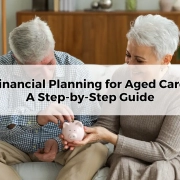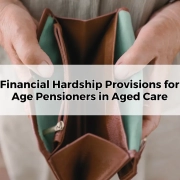How to Use Equity from the Family Home for Aged Care Costs
Table of Contents
ToggleAustralia’s aged care system is increasingly expensive, and many families are grappling with how to meet these rising costs. For many Australians, the family home is their most significant asset, and it can play a pivotal role in funding aged care services. As life expectancy continues to rise, it’s becoming more common to use home equity to pay for aged care. The ability to access these funds offers a lifeline for families who might not have the liquid cash available to meet aged care expenses.
The family home, which has provided comfort and stability over the years, can now provide financial flexibility. With proper planning, home equity can be a key tool to afford quality care without jeopardising long-term financial security. Understanding how to utilise this asset effectively requires a clear grasp of the available options and the long-term impact on personal finances.
What is Home Equity and How Does It Work?
Home equity refers to the value of your home minus any outstanding mortgage or loans against it. It represents the portion of the property that you truly “own” and can be accessed for various purposes, including funding aged care. The more you’ve paid off on your mortgage, or the longer you’ve owned your home, the more equity you are likely to have.
Calculating home equity is relatively simple. If your home is worth $800,000 and you owe $200,000 on your mortgage, you have $600,000 in home equity. For many retirees, this represents their largest asset. Unlocking this value can provide a substantial source of funds to cover the significant costs associated with aged care, especially when other income streams are limited. Understanding how much equity is available is the first step in determining how it can be used for aged care.
The Importance of Accessing Equity for Aged Care
The need for aged care services often arises suddenly, leaving families unprepared for the associated financial burden. With accommodation deposits, ongoing care fees, and additional living expenses to consider, the costs can quickly escalate. For many retirees, cash savings and pensions simply aren’t enough to cover these expenses, and that’s where home equity comes into play.
By leveraging the equity in their home, individuals can unlock a significant financial resource that would otherwise remain untapped. This can provide the necessary funds to secure quality aged care, ensuring the individual receives the care they need while alleviating financial stress on the family. Furthermore, by maintaining ownership of the home, individuals can retain a sense of stability and control over their assets.
Options for Unlocking Equity in Your Home
Several methods are available for accessing home equity, each with its own benefits and drawbacks. The most common approaches include reverse mortgages, home reversion schemes, and selling the family home outright. Each option offers a different way of converting home equity into cash, and it’s crucial to understand which one aligns best with your financial situation and long-term goals.
Reverse mortgages allow you to borrow against the value of your home while continuing to live there. Home reversion schemes, on the other hand, involve selling a portion of your home in exchange for a lump sum or regular payments. Finally, selling the home outright provides immediate funds but comes with emotional and financial considerations, such as the loss of family legacy and potential impacts on social security benefits.
Reverse Mortgages Explained
A reverse mortgage is a financial product that allows homeowners to borrow against the value of their home without the need to make regular repayments. The loan is typically repaid when the homeowner sells the property, moves into aged care permanently, or passes away. For many retirees, this offers a practical way to access equity without selling their home outright.
However, reverse mortgages come with risks. Interest is compounded over time, which means the debt can grow rapidly, reducing the amount of equity left in the property. It’s important to consider whether a reverse mortgage is the best option for long-term financial stability, especially when the goal is to fund aged care costs that can stretch over many years.
Home Reversion Schemes as an Alternative
Home reversion schemes provide an alternative to reverse mortgages. With a home reversion, the homeowner sells a share of their property to a reversion provider in exchange for a lump sum or regular payments. Unlike a reverse mortgage, there’s no loan to repay, and the homeowner continues living in the property for the remainder of their life.
However, home reversion schemes come with trade-offs. The portion of the property sold will not benefit from future property value increases, meaning the homeowner could miss out on potential capital gains. Additionally, the sale price for the share of the home is typically below market value, which can reduce the total funds available for aged care. Understanding these limitations is critical when considering this option.
Selling the Family Home to Fund Aged Care
For some families, selling the family home is the most straightforward way to unlock equity for aged care costs. This option provides immediate access to the full value of the home, which can be used to pay for accommodation deposits, care fees, and other expenses. While selling offers a clean solution, it also comes with emotional challenges, particularly if the home has been in the family for decades.
The decision to sell should not be taken lightly. It’s important to weigh up the financial benefits against the emotional impact of leaving a home full of memories. Furthermore, selling the home may affect eligibility for government benefits such as the Age Pension, so careful planning is essential.
Using Equity to Pay for Accommodation Deposits (RADs and DAPs)
When entering aged care, families are often required to pay a Refundable Accommodation Deposit (RAD) or Daily Accommodation Payment (DAP). These fees can be substantial, and for many retirees, their liquid assets are insufficient to cover the costs. Home equity can be a lifeline in this situation, providing the necessary funds to secure a place in an aged care facility.
A RAD is a lump sum payment that is refunded (minus any agreed deductions) when the individual leaves care. A DAP, on the other hand, is an ongoing daily payment, calculated based on the amount of the RAD that hasn’t been paid. By using home equity to cover these costs, families can avoid dipping into other savings or investments, preserving their financial security.
Impact of Equity Release on Centrelink and Age Pension
One of the key considerations when using home equity for aged care is how it will impact eligibility for government benefits such as the Age Pension. Releasing equity from the family home may affect both the assets and income tests used by Centrelink to determine pension entitlements. Depending on the method chosen, such as a reverse mortgage or home reversion, the effects on benefits can vary.
It’s essential to work with a financial adviser to assess how accessing equity will impact government support. In some cases, it may be possible to structure the release of equity in a way that minimises its impact on Age Pension eligibility. However, without careful planning, families may find that their entitlements are reduced or eliminated altogether.
Tax Considerations When Using Home Equity for Aged Care
Using home equity to fund aged care can have various tax implications. For example, if you sell your home or a portion of it, there may be capital gains tax to consider. Additionally, any income derived from a home reversion or reverse mortgage may affect taxable income, which can have further financial ramifications.
Understanding the tax implications of each equity release option is crucial. While home equity can provide much-needed funds for aged care, it’s important to ensure that you’re not creating unnecessary tax burdens for yourself or your family. Working with a financial adviser who specialises in aged care can help you navigate these complexities.
The Role of Financial Advice in Managing Home Equity
Making the decision to use home equity for aged care is a significant financial and emotional commitment. Seeking specialised financial advice is essential to ensure that the chosen strategy aligns with both short- and long-term financial goals. A qualified adviser can help assess the available options, weigh the pros and cons, and develop a tailored plan that maximises financial security while meeting aged care needs.
Without the right advice, families may make decisions that have unintended consequences, such as losing access to government benefits or overextending their financial resources. By working with an adviser who understands the complexities of aged care and equity release, families can feel confident that they are making informed decisions that will benefit them in the long run.
Final Thoughts
Planning for aged care is one of the most important financial decisions families will face, and home equity can be a powerful tool in funding this transition. However, it’s not a decision to be taken lightly. With the right advice and careful planning, home equity can be used to ensure a comfortable and secure future in aged care, while preserving financial independence for years to come.
Taking a proactive approach now, rather than waiting until the need for care arises, can help families navigate the complexities of aged care funding and ensure that they are well-prepared for whatever the future holds.









